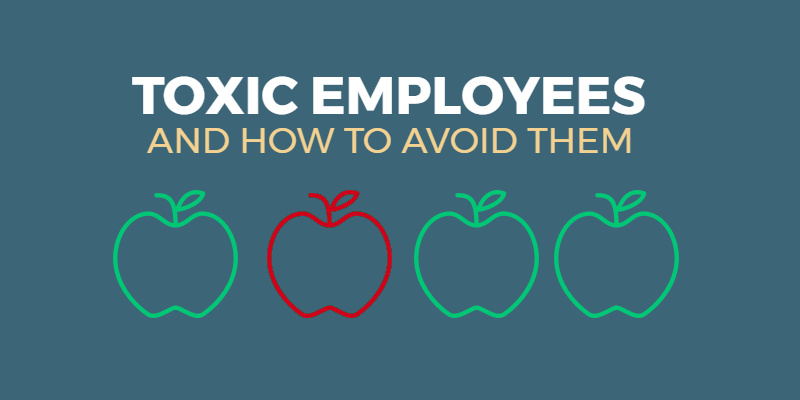
Toxic Employees and How to Avoid Them
Toxic employees. We’ve all been subjected to them at some point. Like in every interpersonal relationship, there will be ups and downs, however a toxic employee is one whose downs far outweigh any “ups” or benefits they bring to your business. Their behaviour could negatively affect other employees, your company’s reputation, profits, or other factors of your business.
A Cornerstone OnDemand report found that quality employees would be more likely to quit by 54% when working with an employee who creates a toxic atmosphere. An entire team’s performance can go down by up to 30% if they are saddled with a toxic employee. A Harvard Business School report similarly claims businesses can lose more than $15,000 a year by keeping a toxic employee around. It appears that good employees will not stand for working in a business with an unpleasant atmosphere from a toxic employee.
Beyond the economics, employee satisfaction falls from working in an environment where they feel under pressure, stressed, beleaguered and under-appreciated.
What makes a toxic employee? Toxic employees at first glance could seem like the perfect over-achiever. But there are traits and personality aspects which could help you identify toxic behaviours. For example, someone who sees themselves as an independent worker could also be inconsiderate of team atmospheres, often believing they alone can achieve the objective. This overconfidence and arrogance can be their downfall, but it is also telling. A study found participants were 43% more likely to behave toxically if they were the type to over-exaggerate or overestimate their technical abilities. Employees with a high self-proclaimed attentiveness to rules are also 33% more likely to be toxic. Alternately, toxic employees could sign themselves up for many different team projects, giving themselves the appearance of being “very busy” all the while avoiding meaningful labour.
Clearly, it’s important to avoid hiring toxic employees at all costs. Research by Minor and Houseman found 1 in 20 employees had their employment terminated as a result of toxic behaviour. There are a few ways to prevent the situation from progressing that far.
Interview smart
Psychometric testing and thorough vetting are both good ways to weed out potential employees, but perhaps the best indication can come from the interview. There are a number of qualities you should pay heed to when screening your potential employees, including respect, loyalty, courage, listening skills, commitment, trust, and gratitude.
These qualities can give you a better idea of the candidate than their resume or qualifications. CEO of software company Fishbowl, David Williams, asks potential employees for examples or stories of when they felt they best embodied these qualities. He also seeks out referees other than those provided; generally someone who has previously directly worked with the potential employee.
Dylan Minor, one of the authors of the Harvard study on toxic employees, believes in the importance of screening employees for “corporate citizenship.” This means looking beyond what the employee can offer in terms of productiveness and service, into how they think about business, and how they can contribute.
Once employees are hired, it’s of use to build a working environment that does not allow for toxic employees and their behaviours to take root. Good communication and trust between managers and employees can allow employees to give constructive feed back, and feel safe in expressing how they feel. Surveys and meetings are a good way to encourage this.
Sometimes, you can put all these measures into place, and still find yourself with a toxic employee. How do you face this challenge in a way that benefits everyone involved?
Be upfront
The best way to do this, according to Bruce Tulgan, the writer of The 27 Challenges Managers Face, is head on. Meet with the toxic employee, and lay out the issues as you see them. Make it explicitly clear what each problem is, and an example of it.
Watch how they behave in the coming weeks, and provide consistent communication about how they are doing to rectify these behaviours. Ensure you are easy to understand, honest, and straightforward. If the employee persists with their toxic attitudes and behaviours, you have grounds for terminating employment.
Tulgan’s ideas of how to deal with a current toxic employee are valuable, but most of the time it will not get to that stage. Hopefully, with this information, you can hire and cultivate the best workforce for your company.